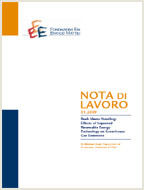Does the Cause of Death Matter? The Effect of Dread, Controllability, Exposure and Latency on the Vsl

12.10.2010
Anna Alberini, Milan Šcasný
I18, J17, K32, Q51
VSL, Conjoint Choice Experiments, Mortality Risk Reductions, Cost-benefit Analysis, Forced Choice Questions
Climate Change and Sustainable Development
Carlo Carraro
The Value of a Statistical Life is a key input into the calculation of the benefits of environmental policies that save lives. To date, the VSL used in environmental policy analyses has not been adjusted for age or the cause of death. Air pollution regulations, however, are linked to reductions in the risk of dying for cancer, heart disease, and respiratory illnesses, raising the question whether a single VSL should be applied for all of these causes of death. We conducted a conjoint choice experiment survey in Milan, Italy, to investigate this question. We find that the VSL increases with dread, exposure, the respondents’ assessments of the baseline risks, and experience with the specific risks being studied. The VSL is higher when the risk reduction is delivered by a public program, and increases with the effectiveness rating assigned by the respondent to public programs that address specific causes of death. The effectiveness of private risk-reducing behaviors is also positively associated with the VSL, but the effect is only half as large as that of public program effectiveness. The coefficients on dummies for the cause of death per se—namely, whether it’s cancer, a road traffic accident or a respiratory illness—are strongly statistically significant. All else the same, the fact that the cause of the death is “cancer” results in a VSL that is almost one million euro above the amount predicted by dread, exposure, beliefs, etc. The VSL in the road safety context is about one million euro less than what is predicted by dread, exposure, beliefs, etc. These effects are large, but the majority of the variation in the VSL is accounted for by the public program feature, the effectiveness of public programs at reducing the indicated risk, and dread. The effects of exposure and experience are smaller. These results raise the question whether using VSL figures based on private risk reduction, which is usually recommended to avoid double-counting, severely understates how much a society might be willing to pay for public safety.
